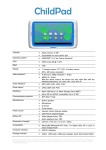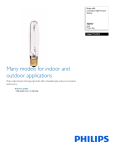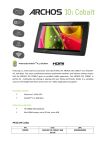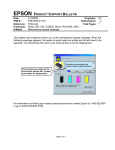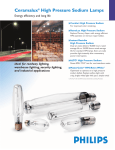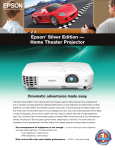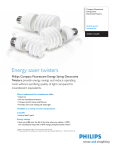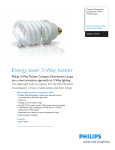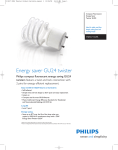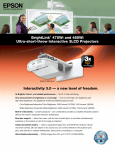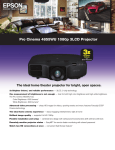Download Philips ED231 User's Manual
Transcript
Ceramalux® High Pressure Sodium Non-Cycling 100 Watt ED231⁄2 (Clear) Lamp Featuring ALTO® Lamp Technology w Ordering Information Ordering Code ANSI Designation Product Number Description Package Quantity 7 3/4" C100S54/ALTO NC HPS 12PK S54 14740-5 High Pressure Sodium TCLP* Compliant Non-Cycling 12 w Physical Characteristics 5" Bulb Size Bulb Finish Base Maximum Overall Length (MOL) Light Center Length (LCL) Arc Length Arc Tube Length Arc Tube Material Max. Permissible Bulb Temp. Max. Permissible Base Temp. Max. Bulb to Base Eccentricity Max. Arc Tube to Base Eccentricity ED 231⁄2 Clear Mogul Screw 73⁄4'' (197mm) 5'' (127mm) 1.3'' (33.4mm) 2.24'' (57mm) Aluminum Oxide 400°C (752°F) 210°C (410°F) 3° 3° w Operating Characteristics (Photometric) Approx. Initial Lumens1 10,000 Approx. Mean Lumens2 9000 4 Rated Average Life, Hours 30,000 Correlated Color Temperature (CCT)3, 5 2100 K CIE Chromaticity Approximate3 x-.520, y-.420 Color Rendering Index (CRI) 18 Efficacy (lpw) 100 w Operating Position Universal w TCLP* Characteristics Toxicity Characteristic Leaching Procedure (US EPA TCLP) Results Hg Pb EPA Limit (mg/l) max 0.200 5.00 C100S54/ALTO NC HPS 0.087 <0.11 Mercury (mg/lamps) max 3.4 Philips Lighting Company 200 Franklin Square Drive P.O. Box 6800 Somerset, NJ 08875-6800 1-800-555-0050 Philips Lighting 281 Hillmount Road Markham, Ontario Canada L6C 2S3 1-800-555-0050 www.philips.com A Division of Philips Electronics Ltd. A Division of Philips Electronics North America Corporation Updated 09/05 TDS-147405 Ceramalux® High Pressure Sodium Non-Cycling 100 Watt ED231⁄2 (Clear) Lamp Featuring ALTO® Lamp Technology Lamp Watts (Nominal) . . . . . . . . . . . . . . . . . . . . . . . . . . 100 Lamp Operating Voltage (rms) (Nominal)3 . . . . . . . . . . . 65 Initial Lamp Voltage Range (rms)6 . . . . . . . . . . . . . . . . . . 57–73 Lamp Operating Current (Amps) (rms) (Nominal) . . . . 2.1 Maximum Lamp Starting Current (Amps) (rms) . . . . . . 3.2 Lamp Current Crest Factor (Maximum) . . . . . . . . . . . . 1.8 Warm-up Time to 80% of Output . . . . . . . . . . . . . . . . . 5 Minutes Restrike Time for Hot Lamp. . . . . . . . . . . . . . . . . . . . . . 5 Minutes Ballast Type . . . . . . . . . . . . . . . . . . . . . . . . . . . . . . . . . . . ANSI S54 Ballast Open Circuit Voltage (Minimum) . . . . . . . . . . . . 110 Pulse Peak Volts . . . . . . . . . . . . . . . . . . . . . . . . . . . . . . . . 2500 Min., 4000 Max. Pulse Width @ 90% Peak . . . . . . . . . . . . . . . . . . . . . . . . 1 Micro Second Minimum Pulse Frequency (Minimum) Lag Ballast . . . . . . . . . . . . . . . . . . . . . . . . . . . . . . . . . . . . 1 per Cycle Lead Circuit Ballast . . . . . . . . . . . . . . . . . . . . . . . . . . . . . 1 per Half Cycle Minimum Operating Temperature. . . . . . . . . . . . . . . . . . -30°C Reference Ballast Impedance . . . . . . . . . . . . . . . . . . . . . 44 Ohms at 120V RIV Maximum Lamp Watts . . . . . . . . . . . . . . . . . . . . . . . . . . 124 Minimum Lamp Watts . . . . . . . . . . . . . . . . . . . . . . . . . . . 72 Maximum Voltage Increase by Fixture . . . . . . . . . . . . . . 4 Approximate Survival Curve for ALTO NC HPS Lamps: Approximate Lumen Maintenance Curve for ALTO NC HPS Lamps: 100 90 90 80 70 60 0 %0 20 40 60 80 Percent of Rated Average Life4 100 Percent – Approx. Initial Lumens Percent – Approx. Initial Lumens 100 80 70 60 50 0 %0 20 40 60 80 Percent of Rated Average Life4 100 Footnotes: 1) Measured at 100 hrs. life. Approximate lumen values listed are for vertical or horizontal operation of lamp. 2) Approximate mean lumen output at 40% of lamp rated average life. 3) Measured at rated lamp watts on a linear reactor. LPW does not include ballast losses. 4) Rated average life is the life obtained, on the average, from large representative groups of lamps in laboratory tests under controlled conditions at 10 or more operating hours per start. It is based on survival of 65% of the lamps and allows for individual lamps or groups of lamps to vary considerably from the average. 5) Approximate color temperature in Kelvin degrees. 6) Measured with the lamp operating at rated watts. Measured lamp voltage will change as the ballast changes lamp wattage. * The TCLP is the US EPA’s Toxicity Characteristic Leaching Procedure WARNINGS, CAUTIONS AND OPERATING INSTRUCTIONS for Ceramalux High Pressure Sodium Lamps R “WARNING: These lamps must be operated in fixtures designed for use with High Pressure Sodium lamps.The fixture wattage rating must match the wattage indicated on the outer glass bulb. Do not scratch the outer bulb or subject it to pressure as this could cause the outer bulb to crack or shatter. A partial vacuum in the outer bulb may cause glass to fly if the glass is struck. Operating the lamp improperly may result in PERSONAL INJURY, PROPERTY DAMAGE, BURNS AND FIRE. 1) If the outer glass bulb is broken, shut off power immediately and remove the lamp after it has cooled. 2) Use only auxiliary equipment meeting Philips and/or ANSI standards. Use within voltage limits recommended by ballast manufacturer. A. Operate lamp only within specified limits of operation. B. For total supply load refer to ballast manufacturers electrical data. 3) Protect lamp base, socket and wiring against moisture, corrosive atmospheres and excessive heat. 4) Replace the lamp if the outer glass bulb has been scratched, cracked or damaged in any way. 5) If a lamp bulb support is used, be sure to insulate the support electrically so as to avoid possible decomposition of the bulb glass. 6) Do not use this lamp in a fixture which redirects a substantial portion of the energy toward the arc tube and its immediate vicinity, as this may lead to very early lamp failure. 7) Take care in handling and disposing of lamps. If arc tube is broken, avoid skin contact with any of the contents or fragments. 8) The arc tube of this lamp contains sodium and mercury. Dispose of in accordance with federal, state and local requirements.


